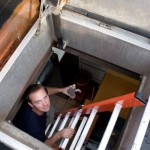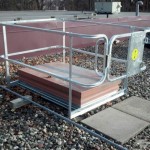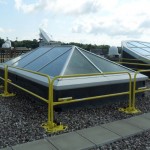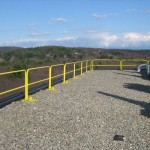Guardrails for Rooftop Hatches, Skylights, and Roof Edges
 In our last blog post, we talked about how to identify fall hazards on a rooftop. Today, we will look at the fall protection equipment that is available to handle some of these hazards. Not every hazard can be avoided using safety equipment. But there are several types of fall protection systems that you can use to provide a solution to hazards such as:
In our last blog post, we talked about how to identify fall hazards on a rooftop. Today, we will look at the fall protection equipment that is available to handle some of these hazards. Not every hazard can be avoided using safety equipment. But there are several types of fall protection systems that you can use to provide a solution to hazards such as:
- Hatches
- Skylights
- Unprotected edges and parapets
Fall Protection for Hatches
 Workers have a tendency to leave hatches open. Either they need to move freely between the roof and the floors below during the job, or they leave the hatch open because they don’t want to be locked out.
Workers have a tendency to leave hatches open. Either they need to move freely between the roof and the floors below during the job, or they leave the hatch open because they don’t want to be locked out.
But an open hatch is a serious hazard. A worker can trip on a misplaced object, or slip on a slick spot, and fall through the open hatch. Or, if they get careless while doing their work, they can mistakenly step backwards into an open hatch, and drop through it.
OSHA regulations require you to have a barrier around hatches while work is being performed in adjacent areas. If there is no permanent guardrail installed, you can set up a temporary system. These systems feature modular, prefabricated sections that can be locked together and set up in various configurations around hatches of different sizes. The base plate supports of these portable systems require no building penetration, and the top rails of the are capable of withstanding a force of up to 200 lbs.
Even if there is a permanent barrier installed around a hatch, you may need to also use a portable guardrail. Ideally, a permanent barrier should have a self-closing swing gate that automatically closes after workers walk through it. But some older permanent guardrails only have a safety chain attachment across the opening. Workers must unhook the chain (assuming it’s still there after all these years), pass through the opening, and reattach the chain each time they use the hatch.
These types of “safety chain” setups are not safe at all. Unlike the top rail of a portable guardrail, a safety chain is not able to withstand the weight of a falling worker. A worker’s weight will break the chain, and they will continue falling through the open hatch. Not only that, these types of safety chain attachments are considered a violation of OSHA regulations. Therefore, if the hatch has a safety chain opening, you may need to use a portable guardrail as a stopgap.
Fall Protection for Skylights
 You might not think that skylights would be a fall hazard for workers, but that’s exactly what they are. In most cases, the glass covering on a skylight is only meant to provide natural light to the room below, while keeping out rain and snow from above.
You might not think that skylights would be a fall hazard for workers, but that’s exactly what they are. In most cases, the glass covering on a skylight is only meant to provide natural light to the room below, while keeping out rain and snow from above.
As recently as 2011, a worker in California – a man with 25 years experience with the roofing company he worked for – fell through a glass skylight to his death. The fact is, a glass skylight will not support the weight of a worker who falls against it.
If skylights are present, you should at least put a portable guardrail around them, as you would with a hatch. A more practical solution is the skylight screen or skylight dome. This stainless steel screen can be attached to the sides of a skylight’s border, and placed over the skylight, to catch workers if they trip and fall against it, preventing them from crashing through the skylight.
Portable Rooftop Guardrails
 Any unprotected edge, or any ledge or area where the abutting level drops off more than four feet, is a fall safety hazard. An edge that is surrounded by a parapet less than 42 inches (3 1/2 feet) in height also requires fall protection.
Any unprotected edge, or any ledge or area where the abutting level drops off more than four feet, is a fall safety hazard. An edge that is surrounded by a parapet less than 42 inches (3 1/2 feet) in height also requires fall protection.
Portable systems are available for roof edges. These systems come with a variety of non-penetrating base configurations, so they can be adapted to multiple types of surfaces. These base configurations include:
- Standard, non-penetrating base plates.
- L-shaped counterbalance assemblies that keep the posts upright along an unprotected edge.
- Clamps that allow the system to be clamped onto parapets, or onto concrete slabs or floors.
- Horizontal base plates that can be used to set up the guardrail on standing seam metal, gravel, or asphalt roofs.
- Optional toeboards that can be set up along an unprotected edge to prevent tools from being kicked over the side.
Portable guardrail systems are usually made up of modular, prefabricated sections that can be locked together. This is useful, because you can adapt the system to the layout and shape of the surface needing protection. You can turn the sections around corners, and if necessary, connect them with sections on parapets, to form one continuous guardrail system around the entire perimeter.
NOTE: This is one of a series of articles about fall protection equipment for rooftop workers. Stay tuned for more!

